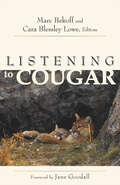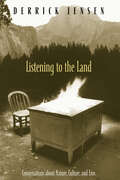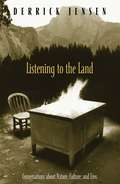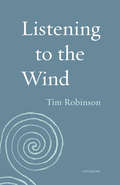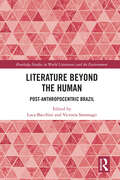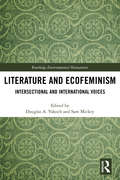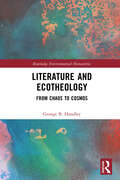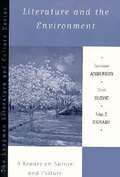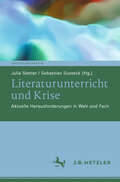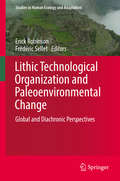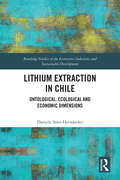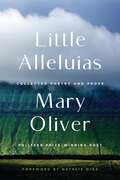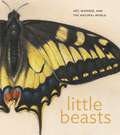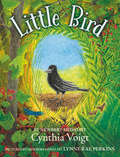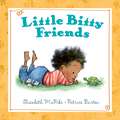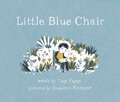- Table View
- List View
Listening to Cougar
by Marc Bekoff Cara Blessley LoweThis spellbinding tribute to Puma concolor honors the big cat's presence on the land and in our psyches. In some essays, the puma appears front and center: a lion leaps over Rick Bass's feet, hurtles off a cliff in front of J. Frank Dobie, gazes at Julia Corbett when she opens her eyes after an outdoor meditation, emerges from the fog close enough for poet Gary Gildner to touch. Marc Bekoff opens his car door for a dog that turns out to be a lion. Other works evoke lions indirectly. Biologists describe aspects of cougar ecology, such as its rugged habitat and how males struggle to claim territory. Conservationists relate the political history of America's greatest cat. Short stories and essays consider lions' significance to people, reflecting on accidental encounters, dreams, Navajo beliefs, guided hunts, and how vital mountain lions are to people as symbols of power and wildness. Contributors include: Rick Bass, Marc Bekoff, Janay Brun, Julia B. Corbett, Deanna Dawn, J. Frank Dobie, Suzanne Duarte, Steve Edwards, Joan Fox, Gary Gildner, Wendy Keefover-Ring, Ted Kerasote, Christina Kohlruss, Barry Lopez, BK Loren, Cara Blessley Lowe, Steve Pavlik, David Stoner, and Linda Sweanor.
Listening to Cougar
by Marc Bekoff Cara Blessley Lowe&“Awe. It&’s the overwhelming emotion 20 authors express for the cougar—or mountain lion or panther or puma—in [this] beautiful literary anthology.&” —The Durango Herald Foreword by Jane Goodall This spellbinding tribute to Puma concolor honors the big cat&’s presence on the land and in our psyches. In some essays, the puma appears front and center: a lion leaps over Rick Bass&’s feet, hurtles off a cliff in front of J. Frank Dobie, gazes at Julia Corbett when she opens her eyes after an outdoor meditation, emerges from the fog close enough for poet Gary Gildner to touch. Marc Bekoff opens his car door for a dog that turns out to be a lion. Other works evoke lions indirectly. Biologists describe aspects of cougar ecology, such as its rugged habitat and how males struggle to claim territory. Conservationists relate the political history of America&’s greatest cat. Short stories and essays consider lions&’ significance to people, reflecting on accidental encounters, dreams, Navajo beliefs, guided hunts, and how vital mountain lions are to people as symbols of power and wildness. Contributors include: Rick Bass, Marc Bekoff, Janay Brun, Julia B. Corbett, Deanna Dawn, J. Frank Dobie, Suzanne Duarte, Steve Edwards, Joan Fox, Gary Gildner, Wendy Keefover-Ring, Ted Kerasote, Christina Kohlruss, Barry Lopez, BK Loren, Cara Blessley Lowe, Steve Pavlik, David Stoner, and Linda Sweanor. &“Puma. Cougar. Mountain lion. Panther. These words and the creatures they represent inspire awe, wonder, excitement, terror, and reverence in the writers whose contributions make up this anthology.&” —Library Journal
Listening to the Land: Conversations about Nature, Culture and Eros
by Derrick JensenIn this far-ranging and heartening collection, Derrick Jensen gathers conversations with environmentalists, theologians, Native Americans, psychologists, and feminists, engaging some of our best minds in an exploration of more peaceful ways to live on Earth. Included here is Dave Foreman on biodiversity, Matthew Fox on Christianity and nature, Jerry Mander on technology, and Terry Tempest Williams on an erotic connection to the land. With intelligence and compassion, Listening to the Land moves from a look at the condition of the environment and the health of our spirit to a beautiful evocation of eros and a life based on love.
Listening to the Land: Conversations about Nature, Culture, and Eros
by Derrick JensenDeclaring American culture "the most destructive culture ever to exist," this work presents 29 interviews with a range of activists, theologians, psychologists, and other thinkers who trace a range of themes of related to the relationship between culture and environmental destruction. Among the figures interviewed are Earth First! cofounder Dave Foreman, historian of religion Thomas Berry, technology critic Jerry Mander, Chickasaw poet and novelist Linda Hogan, psychologist Robert Jay Lifton, Native American scholar and activist Ward Churchill, and feminist and peace activists Starhawk. Annotation ©2004 Book News, Inc., Portland, OR (booknews.com)
Listening to the Wind
by Tim RobinsonA mapmaker’s vivid journey through the geography, ecology, and history of Ireland’s Connemara region.Here is Connemara, experienced at a walker’s pace. From cartographer Tim Robinson comes the second title in the Seedbank series, a breathtakingly intimate exploration of one beloved place’s geography, ecology, and history.We begin with the earth right in front of his boots, as Robinson unveils swaths of fiontarnach—fall leaf decay. We peer from the edge of the cliff where Robinson’s house stands on rickety stilts. We closely examine an overgrown patch of heather, a flush of sphagnum moss. And so, footstep by footstep, moment by moment, Robinson takes readers deep into this storied Irish landscape, from the “quibbling, contentious terrain” of Bogland to the shorelines of Inis Ní to the towering peaks of Twelve Pins.Just as wild and essential as the countryside itself are its colorful characters, friends and legends and neighbors alike: a skeletal, story-filled sheep farmer; an engineer who builds bridges, both physical and metaphorical; a playboy prince and cricket champion; and an enterprising botanist who meets an unexpected demise. Within a landscape lie all other things, and Robinson rejoices in the universal magic of becoming one with such a place, joining with “the sound of the past, the language we breathe, and our frontage onto the natural world.” Situated at the intersection of mapmaking and mythmaking, Listening to the Wind is at once learned and intimate, elegiac and magnificent—an exceptionally rich “book about one place which is also about the whole world” (Robert Macfarlane).“Visitors to Connemara, that expanse of stony beauty in the west of Ireland, are often struck by its stillness. [This] collection of essays succeeds in the difficult task of staying true to the verities of a place on to which so many fantasies have been projected.” —The Guardian
Literary Feminist Ecologies of American and Caribbean Expansionism: Errand into the Wilderness (Routledge Environmental Literature, Culture and Media)
by Christine M. Battista Melissa R. SandeThis book synthesizes ecofeminist theory, American studies, and postcolonial theory to interrogate what New Americanist William V. Spanos articulates as the "errand into the wilderness": the ethic of Puritanical expansionism at the heart of the U.S. empire that moved westward under Manifest Destiny to colonize Native Americans, non-whites, women, and the land. The project explores how the legacy of the errand has been articulated by women writers, from the slave narrative to contemporary fiction. Uniting texts across geographical and temporal boundaries, the book constructs a theoretical approach for reading and understanding how women authors craft counter-narratives at the intersection of metaphorical and literal landscapes of colonization. It focuses on literature from the United States and the Caribbean, including the slave narratives by Sojourner Truth, Harriet E. Wilson, and Harriet Jacobs, and contemporary work by Toni Morrison, Maryse Condé, Edwidge Danticat, and Native American writer Linda Hogan. It charts the contrast between America’s earliest idyllic visions and the subsequent reality: an era of unprecedented violence against women of color and the environment. This study of many canonical writers presents an important and illuminating analysis of American mythologies that continue to impact the cultural landscape today. It will be a significant discussion text for students, scholars, and researchers in environmental humanities, ecofeminism, and postcolonial studies.
Literary Trails: Haworth and the Brontës (Literary Trails Ser.)
by Catherine Rayner David F. WalfordA journey through the English town where the Brontë sisters lived and wrote—for visitors or armchair travelers. Includes photos and two dozen maps. This lighthearted but deeply researched book offers interest and guidance to walkers, social historians, and lovers of the Brontë family, their lives and works. Set in and around the town of Haworth, it allows you to explore this unique area of Yorkshire and walk in the footsteps of those who knew and loved this town and its moorlands two hundred years ago. With guided tours around special buildings as well as outdoor walks and the history of people and places who lived and worked in Haworth over centuries, it offers an insight into life and death in the melee of the Industrial Revolution. Its authors have combined their lifelong interests in Victorian literature and social history with writing, walking, photography, and cartography, and have included quotes from Brontë poetry and novels.
Literature Beyond the Human: Post-Anthropocentric Brazil (Routledge Studies in World Literatures and the Environment)
by Luca Bacchini Victoria SaramagoHow can Clarice Lispector’s writings help us make sense of the Anthropocene? How does race intersect with the treatment of animals in the works of Joaquim Maria Machado de Assis? What can Indigenous philosopher and leader Ailton Krenak teach us about the relationship between environmental degradation and the production of knowledge? Literature Beyond the Human is the first collection of essays in English dedicated to an investigation of Brazilian literature from the viewpoint of the environmental humanities, animal studies, Anthropocene studies, and other critical and theoretical perspectives that question the centrality of the human. This volume includes 15 chapters by leading scholars covering two centuries of Brazilian literary production, from Gonçalves Dias to Astrid Cabral, from Euclides da Cunha to Davi Kopenawa, and others. By underscoring the vast theoretical potential of Brazilian literature and thought, from the influential Modernist thesis of “cultural cannibalism” (antropofagia) to the renewed interest in Amerindian perspectivism in culture. Post-Anthropocentric Brazil shows how the theoretical strength of Brazilian thought can contribute to contemporary debates in the anglophone realm.
Literature and Ecofeminism: Intersectional and International Voices (Routledge Environmental Humanities)
by Douglas A. Vakoch Sam MickeyBringing together ecofeminism and ecological literary criticism (ecocriticism), this book presents diverse ways of understanding and responding to the tangled relationships between the personal, social, and environmental dimensions of human experience and expression. Literature and Ecofeminism explores the intersections of sexuality, gender, embodiment, and the natural world articulated in literary works from Shakespeare through to contemporary literature. Bringing together essays from a global group of contributors, this volume draws on American literature, as well as Spanish, South African, Taiwanese, and Indian literature, in order to further the dialogue between ecofeminism and ecocriticism and demonstrate the ongoing relevance of ecofeminism for facilitating critical readings of literature. In doing so, the book opens up multiple directions for ecofeminist ideas and practices, as well as new possibilities for interpreting literature. This comprehensive volume will be of great interest to students and scholars of ecocriticism, ecofeminism, literature, gender studies, and the environmental humanities.
Literature and Ecotheology: From Chaos to Cosmos (ISSN)
by George B. HandleyLiterature and Ecotheology: From Chaos to Cosmos challenges us in a time of climate crisis to find more common ground between the dual projects of ecocriticism and ecotheology.This book argues that in our postsecular age, literature has become an important repository of theological wisdom that can, like formal work in ecotheology, provide the moral grounds for environmental care. However, for any cosmological understanding to be adequate to the challenges before us, it must be responsive to the often-painful contingencies and uncertainties that inhere in the cosmos, something that both ecocriticism and ecotheology have often neglected. After a treatment of the ecocritical and ecotheological questions that pertain to the religious/secular divide, the study then turns to four contemporary American writers—Annie Dillard, Cormac McCarthy, Marilynne Robinson, and David James Duncan—as examples. Each uses the contingency of literary form and its promise of wholeness in order to imagine reasons for hope in light of the unpredictability and untold human and more-than-human suffering that lie at the heart of nature.The book will be of interest to students, scholars and researchers interested in ecotheology, religious studies, environmental literature, the environmental humanities, and environmental studies more broadly. It offers a needed paradigm shift in how Western societies have tended to misuse both secularity and religion.
Literature and the Environment: A Reader on Nature and Culture (The Longman Literature and Culture Series)
by Lorraine Anderson Scott Slovic John P. O'GradyExploring our relationship to nature and the role literature can play in shaping a culture responsive to environmental realities, this thematic, multi-genre anthology includes early writers such as John Muir, Henry David Thoreau, and Mary Austin, alongside contemporary voices such a Gary Snyder and Terry Tempest Williams.
Literaturunterricht und Krise: Aktuelle Herausforderungen in Welt und Fach (Deutschdidaktik)
by Julia Stetter Sebastian SusteckDer Literaturunterricht steht unter Druck. Bildungspolitisch ungeliebt und didaktisch zunehmend ratlos betrachtet, lässt Literatur sich nur schwer in Kompetenzraster integrieren und steht zudem im Verdacht, zu den existenziellen Problemen der Gegenwart zu wenig zu sagen zu haben. Der Band öffnet neue Perspektiven auf den heutigen Literaturunterricht, der in multiplen Krisen gefangen scheint und im Kreuzfeuer von Entwicklungen steht, die allgemein mit Problemen deutscher Schulen assoziiert werden. Die Beiträge betonen dagegen die Bedeutung der Literatur für den Unterricht sowie die Rolle des Literaturunterrichts in der Reaktion auf die Krisen der Gegenwart.
Lithic Technological Organization and Paleoenvironmental Change
by Erick Robinson Frédéric SelletThe objective of this edited volume is to bring together a diverse set of analyses to document how small-scale societies responded to paleoenvironmental change based on the evidence of their lithic technologies. The contributions bring together an international forum for interpreting changes in technological organization - embracing a wide range of time periods, geographic regions and methodological approaches. As technology brings more refined information on ancient climates, the research on spatial and temporal variability of paleoenvironmental changes. In turn, this has also broadened considerations of the many ways that prehistoric hunter-gatherers may have responded to fluctuations in resource bases. From an archaeological perspective, stone tools and their associated debitage provide clues to understanding these past choices and decisions, and help to further the investigation into how variable human responses may have been. Despite significant advances in the theory and methodology of lithic technological analysis, there have been few attempts to link these developments to paleoenvironmental research on a global scale.
Lithic Technological Systems and Evolutionary Theory
by Nathan Goodale William Andrefsky Jr.Stone tool analysis relies on a strong background in analytical and methodological techniques. However, lithic technological analysis has not been well integrated with a theoretically-informed approach to understanding how humans procured, made, and used stone tools. Evolutionary theory has great potential to fill this gap. This collection of essays brings together several different evolutionary perspectives to demonstrate how lithic technological systems are a byproduct of human behavior. The essays cover a range of topics, including human behavioral ecology, cultural transmission, phylogenetic analysis, risk management, macroevolution, dual inheritance theory, cladistics, central place foraging, costly signaling, selection, drift, and various applications of evolutionary ecology.
Lithium Extraction in Chile: Ontological, Ecological and Economic Dimensions (Routledge Studies of the Extractive Industries and Sustainable Development)
by Daniela Soto-HernándezThis book explores lithium extraction in Chile as part of the global energy transition, unravelling the ontological, ecological, and economic dimensions behind this type of extractivism.A transition away from fossil fuels is urgent in the context of climate change and one of the main challenges so far has been to store the variable energy provided by renewable energy sources. Due to its role in the lithium-ion batteries that power electric vehicles, lithium has been framed as a ‘critical mineral’ to transit towards low-carbon economies. Chile is the second lithium-exporting country worldwide and while it aims to expand its production, the delicate wetland ecosystems, and Indigenous territories where lithium comes from face increasing pressure. This book looks at the worlds, ecologies, and economies that are becoming increasingly extracted and the effects of these processes. Drawing on the case of extractivism in the Salar de Atacama watershed in the Antofagasta region in Chile and engaging with Indigenous and non-Indigenous local communities, NGOs, state officials, companies, and lithium workers through a twelve-month ethnography, the book offers a unique perspective into the contested narratives around what is being extracted and the manifold effects of it. By putting the Indigenous cosmovision forward and showing the local experiences with an industry powered by the ongoing energy transition, this book connects the notions of interconnection and fragmentation to provide a wider understanding of future challenges, where ontologies, ecologies, and economies are intertwined. The book weaves together different disciplinary strands and takes them forward to show how the solutions based on extractivism are menacing to destroy the marginalized worlds and ecosystems of human and non-human communities. As such, the book not only fills the gaps in current literature, but also goes further to rethink the ways in which academics engage with natural resources and how the pluriverse is currently experienced in the Salar de Atacama watershed.This book will be of great interest to academics, students, and environmental advocates studying energy transitions, critical minerals, anti-colonial and indigenous perspectives around development, and lithium extraction.
Little Acorn Grows Up
by Edward GibbsLittle Acorn Grows Up is a sweet, simple tale that explores themes of growing up and nature from author/illustrator Edward Gibbs.In this companion book to Little Bee, Little Acorn proves that great things come in small packages as it grows from a tiny nut to a big tree that shelters its forest friends. Poignant and thoughtful, this book features Read Aloud functionality [where available].
Little Alleluias: Collected Poetry and Prose
by Mary OliverAn archival compendium of three complete works by Mary Oliver: the book-length poem The Leaf and the Cloud, the collection What Do We Know, and essays from Long Life—with a foreword by fellow Pulitzer Prize-winning author of Postcolonial Love Poem Natalie Diaz. For the many admirers of Mary Oliver's breathtaking poetry of touch and transcendence, as well as for those coming to her words for the first time, Little Alleluias is a revelation. These works observe, search, pause, astonish, and give thanks to both love and the natural world. In constant conversation with the sublime, (i.e. "Are you afraid? / Somewhere a thousand swans are flying / through winter's worst storm."), Oliver has the rare skill of rendering life: her poems and essays bring movement to stillness, and people to the Earth, themselves, and each other. Page by page, she invites us to walk through her minutes, her moments, and revere the light and dark and rainbowed clothes of world alongside her. With three distinct books collected in one volume for the first time, Little Alleluias asks what passes and what persists, and offers readers the peace that every mind deserves. &“Hers is a purposeful language, one that looks not just with attention but with sensual intention, and though awestruck, seeks to hold, even briefly, the unknowns of the energies that make any life. Little alleluias, she called her writings. Not meant to define but to praise, to rejoice in the maker and what has been made, to dare be heard as a whisper or a shout in this immense world.&”—Natalie Diaz, in her Foreword
Little Bear Looks After Nature (Nature Matters)
by Sue GravesLittle Bear Looks After Nature offers a gentle introduction to the concept of conservation for young children.In this humorous story, Little Bear sees all the problems facing nature in her local environment, and she is determined to make some changes. She encourages others to help her too!This charming book is the perfect way to introduce young children to the concept of conservation. Also included are suggestions for activities and ideas to talk through together to help children understand the concept.The Nature Matters series of picture books provide a gentle means of promoting concepts of environmental issues, boosting self-esteem and reinforcing good behaviour. Supports the Personal, Social and Emotional Development Area of Learning in the Early Years Foundation Stage, and is also suitable for use with children in KS1 and can be used to discuss citizenship and values. Suitable for children aged 3+.
Little Bear: An Inuit Folktale
by Dawn CaseyLittle Bear is a lyrical retelling of an Inuit folktale, written by award-winning author Dawn Casey and radiantly illustrated by award-winning artist Amanda Hall. When a lonely old woman finds a polar bear cub with no mother of his own, she adopts him, and cares for him as he grows. The bear cub rides in her hood and sleeps by her side. The old woman loves the bear like her own child, but her heart also knows: bears belong in the wild. A tender story of loving and learning to let go, Little Bear celebrates the relationship between a human being and a wild animal and will touch the hearts of readers young and old.
Little Beasts: Art, Wonder, and the Natural World
by Alexandra Libby Brooks Rich Stacey SellA richly illustrated look at the intersection of art and science in Renaissance EuropeArt played a pivotal role in the development of natural history during the sixteenth and seventeenth centuries. European colonial expansion enabled naturalists to study previously unknown insects, animals, and other beestjes—&“little beasts&”—from around the globe. Little Beasts explores how artists such as Joris Hoefnagel and Jan van Kessel helped deepen and spread knowledge of these creatures with highly detailed and playful works that inspired generations of printmakers, painters, decorative artists, and naturalists.This appealing book begins by mapping the origins of natural history as a discipline, showing how early illustrated treatises reflected a vibrant exchange between artists and naturalists that contributed to the growth of natural science and sparked public fascination with the animal kingdom. It shares insights into Hoefnagel&’s engagement with contemporary natural history, as demonstrated in his Four Elements—a four-volume series of some three hundred watercolor miniatures of animals—and examines how intaglio printmaking enabled natural history studies to reach new audiences. The volume concludes with a discussion of Van Kessel&’s small oil paintings, likely made for discerning collectors of both natural and artistic curiosities.Blending lively and informative essays with beautiful illustrations, Little Beasts traces the connections between artists, naturalists, and collectors in an age of scientific discovery and broadening horizons, inviting readers to look with wonder at nature&’s variety.Published in association with the National Gallery of Art, Washington, DCExhibition ScheduleNational Gallery of Art, Washington, DCMay 18–November 2, 2025
Little Bee
by Samantha Berger Edward GibbsAll the animals are running away, but what are they afraid of? Find out in this action-packed book that will have all little children wanting to turn the pages and join in. It's simple, it's fun, it's thought provoking, and the surprise ending brings it right back to the beginning - to be enjoyed all over again! Graphic designer and illustrator Edward Gibbs has always sought to communicate meaningful ideas in the simplest way. With a seemingly effortless touch, in this book and its companion The Acorn, he introduces educational themes and concepts (food chains, fear, ecosystems) in a visual, fun, and satisfying romp for the very young.
Little Bird
by Cynthia VoigtCelebrated Newbery Medalist Cynthia Voigt introduces Little Bird, a tiny crow with a big imagination and an even bigger heart, in this timeless read-alone and read-aloud just right for the young middle grade audience. Little Bird features black-and-white illustrations by Newbery Medalist Lynne Rae Perkins throughout. When a wild fisher cat attacks their nest, Little Bird and her flock are devastated. Not only does the fisher cat harm the fledglings, but it also makes off with the shiny pendant that the superstitious crows rely on for good luck. Little Bird believes that she can find the lucky pendant and return it to the nest before disaster strikes. The other crows aren’t so sure—after all, Little Bird is so little and undependable and meek.But with the help of some new friends—including a very funny goat—Little Bird journeys through forests and over lakes and fields, challenging her wits and survival skills along the way. The crow who returns home is wiser, braver, kinder, and ready—at last—to spread her wings. Newbery Medalist Cynthia Voigt’s gentle humor, sense of fun and adventure, and delightful main character sing off the page in this timely short novel about bravery and friendship, illustrated by Newbery Medalist Lynne Rae Perkins. A page-turning read-aloud for families and classrooms, and a terrific book for fans of Nuts to You, by Lynne Rae Perkins, and Avi’s Poppy books.
Little Bitty Friends
by Elizabeth McPikeA cuter-than-puppies companion to Little Sleepyhead Little bitty chipmunks, chattering all the day, Little bitty ladybug always comes to play. Marching with ants, snuggling with baby rabbits, reaching for the sun with happy buttercups--young children form special bonds with nature's little creations. Lyrical verse and charming scenes capture an enchanted world of little bitty friends.
Little Blog on the Prairie
by Cathleen Davitt BellThirteen-year-old Genevieve's summer at a frontier family history camp in Laramie, Wyoming, with her parents and brother is filled with surprises, which she reports to friends back home on the cell phone she sneaked in, and which they turn into a blog.
Little Blue Chair
by Cary FaganA sweet, whimsical tale that chronicles the journey of a chair as it changes hands and uses. Perfect for fans of The Good Little Book, Something for Nothing and Virginia Lee Burton's The Little House.Boo's favorite chair is little and blue. He sits in it, reads in it and makes a tent around it...until the day he grows too big for it. His mother puts the little blue chair out on the lawn where a truck driver picks it up. The truck driver sells it to a lady in a junk store where it sits for many years until it's sold and put to use as a plant stand. In the years that follow, the little blue chair is used in many other ways -- on an elephant ride, in a contest, on a Ferris wheel, in a tree...until the day it flies away, borne aloft by balloons, and lands in a garden of daffodils where a familiar face finds it. A charming, beautifully illustrated read-aloud that follows the adventures of a little chair, beginning as the seat of a small child who loves books and circling back to that child's child many years (and bottoms) later.

